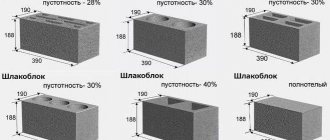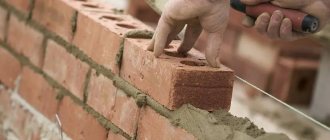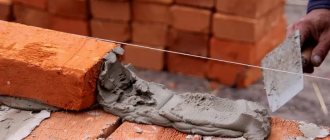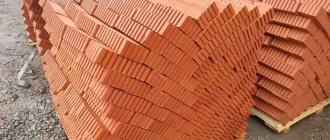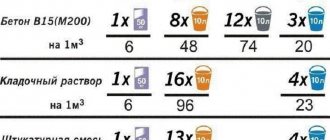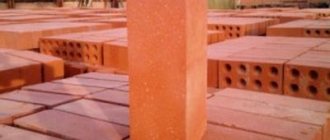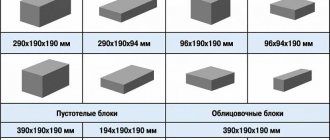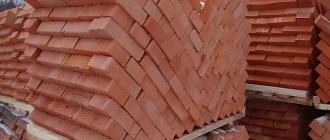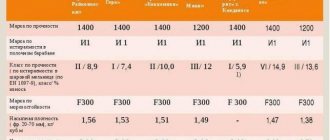When planning brick construction, it is important to foresee all upcoming expenses . One of the items in the estimate will take into account the cost of building materials .
The question will immediately arise about how much it will be needed , and since many construction companies indicate the price for 1 piece, you need to know how many bricks are in a masonry cube .
Also, knowing how much it will be needed will allow you to avoid excess bricks after construction or, conversely, to ensure that work is not interrupted due to a lack of building materials.
The principle of determining brick consumption based on the volume of walls
The methodology is based on determining the quotient of dividing the total volume of walls (adjusted to take into account the deduction of openings for windows and doors) by the volume of one brick.
The result is the required quantity in pieces for brickwork. In practice, the problem is solved through several stages:
- determination of the areas of internal walls and partitions, external load-bearing walls that differ in thickness;
- calculation of the areas of window and door openings;
- subtracting the size of openings from the wall area;
- calculating wall volumes by multiplying their adjusted area by thickness;
- calculation of bricks for laying external, internal walls and partitions by dividing the resulting wall volumes by the volume of one brick.
The task is complicated by the fact that there are seams between the bricks that are filled with mortar. Their standard thickness is taken to be 10 mm, but it can be less if the brick has an ideal geometry. A few millimeters of mortar between bricks on the scale of the entire building grows into a rather impressive value, reducing brick consumption.
A simplified calculation is based on the standard dimensions of a single brick of “normal shape” (1NF) - 250 x 120 x 65 mm (length, width, height). In a cubic meter of masonry, exactly 512.82 pieces of such bricks fit. Taking into account the seams (10 mm), the difference will be 118 bricks, which for the entire facility represents a mountain of unnecessary material. Using an online calculator, the purchase of excess building materials will be eliminated.
Any batch of bricks initially has a certain percentage of defects. Losses are inevitable during loading, transportation and unloading. This damage increases the calculated amount by 5 – 8%.
Summary
As you can see, correct calculations play a special role in the construction business. If the customer knows how to make them well, then it will be difficult to deceive him during the construction process and he will be able to independently control supplies and costs.
Recommended Posts
How to remove marks from a felt-tip pen, marker, pencil, plasticine...
Wood antiseptic: which one is better to choose
How to groove walls and ceilings for wiring
Sliding wardrobe: internal contents + photo
How to correctly write an application for roof repair
How to fight fungus
We will calculate the brick consumption when using certain wall laying schemes
There is additional information about how many bricks there will be in 1m2 of wall masonry in 0.5 bricks:
- single brick, required quantity - 61 pcs. excluding seam, with seam - 51 pieces;
- One-and-a-half bricks needed - 46 pcs. not including the seam, but with the seam 39 pieces;
- double brick, required quantity - 30 pcs. not taking into account the seam, with the seam you need - 26 pieces.
In addition, you need to determine the number of bricks in 1m2 of masonry, subject to construction of 1 brick:
- when building a single one you need - 128 pcs. not including cement, but with seam - 102 pcs.;
- when constructing a one and a half building - 95 pcs. without cement, with a seam - 78 pcs.;
- during double construction - 60 pcs. excluding the seam, or with the seam - 52 pcs.
The amount of brick in 1 m2 of masonry walls of 1.5 bricks has also long been standardized:
- single brick needed - 189 pcs. not taking into account the seam, but with the seam already - 153 pcs.;
- one-and-a-half bricks must be purchased - 140 pcs. excluding seam, with seam only - 117 pcs.;
- double brick is enough - 90 pcs. not taking into account the seam, but with the seam 78 pcs.
In specialized tables it’s time to find out how many bricks are needed in 1m2 of a wall with 2 bricks:
- single - 256 pcs. without seams, with mortar - 204 pcs. ;
- one and a half - 190 pcs. without seams, taking into account the solution - 156 pcs.;
- double — 120 pcs. without solution, and with solution - 104 pcs.
When laying walls with two and a half bricks, you must take into account that in 1 sq. the meter will need the following quantities of building materials:
- single - 317 pcs. and accordingly - 255 pcs.;
- one and a half - 235 pcs. yes and - 195 pcs.;
- double - 150 pcs. and also - 130 pcs.
Knowing all the above information, it is no wonder to calculate the consumption of facing bricks per 1 m2. When used in calculations of seam sizes:
- red plain - 54 pcs.;
- regular facing - 85 pcs.;
- front large - approximately 14 pcs.
It is easy to notice that the calculations are simple and easy; you just need to know the dimensions of the material and the parameters of the building under construction.
Then select the required value from the list and multiply it by the previously calculated wall area. This is how the required amount of building materials to build a house is found. It is also necessary to take into account that the amount of defective material in most cases forms 5-7% of the total volume of building materials. Based on this, it would be best to buy building materials with such a reserve to take into account the battle.
That's all, I hope our article will help you in calculating how many bricks will be needed in 1 m2 of masonry, for different construction options, based on the parameters of the future walls of any of the buildings you are erecting.
Dimensions fixed by GOST
Brick is a stone obtained artificially, which has the correct shape and is widely used in modern construction. All three of its surfaces have their own names: the bed is the side with the largest area, the spoon is with the middle area, and the poke is the side with the smallest. Even during the existence of the Soviet Union, the dimensions of the material were fixed by GOSTs , and currently this information is relevant.
| No. | Title ( marking ) | Dimensions (mm) |
| 1. | Single (O) | 250×120×65 |
| 2. | "Euro" (E) | 250×85×65 |
| 3. | Modular single (M) | 288×138×65 |
| 4. | One and a half (U) | 250×120×88 |
| 5. | Thickened with horizontal voids (UG) | 250×120×88 |
| 6. | Double (K) | 250×120×140 288×288×88 288×138×140 288×138×88 250×250×140 250×180×140 |
| 7. | Large-format stone - ceramic horizontal block (KK) | 510×250×219 398×250×219 380×250×219 380×255×188 380×250×140 380×180×140 250×250×188 |
| 8. | With horizontal voids (KG) | 250×200×70 |
Recommendations
During the construction of walls, not only the calculation of bricks per cubic meter is performed, but also in squares. Like the calculation in m3, this indicator is influenced by the dimensions of the products and the way they are laid, as well as the preferred seam thickness.
When planning construction, do not forget that damage to the material is possible. Therefore, it is necessary not only to determine the exact number of bricks in 1 m3, but also to add about 5% to the figure obtained after calculations.
For a square meter, walls are defined as follows:
- To determine the area of an individual element: 25 is multiplied by 6.5 and you get 162.5 cm2.
- Since one square meter contains 10,000 cm2, further calculations are carried out as follows: 10,000 divided by 162.5, which gives 61.5 pieces of bricks.
If one-and-a-half products are preferable, then to determine their quantity, 25 is multiplied by 8.8 and you get 220 cm2. After this, 10,000 is divided by 220 and you get 25 bricks. The number of double stones is determined in the same way.
Using this method, products of unusual sizes are also calculated, but using the parameters of the side of the brick, and the square meter is divided by the resulting number.
To take into account the seam, add 10-12 mm. Since the material can be laid in different ways, the wall thickness in each structure is different. This may also affect the consumption rates per 1 m3 of masonry.
If the volume of construction is small, then this fact can be ignored
But for large-scale construction, you need to pay attention to every little thing, since due to the wrong approach to the work, you will have to re-purchase the material and stop the entire process of building construction
The consumption rate per 1 m3 of masonry may vary. To determine the indicator, determine the total area of the wall.
Before construction, you first need to find out how many bricks are in 1m3 of masonry; a calculator will help with this. This data will help you purchase as much stone as you need and avoid downtime.
It is important to take into account the amount of brick in 1 m3 of masonry, taking into account the mortar, since this indicator will affect the total amount of products
In the absence of additional time to determine how many ordinary bricks are in a cube, you can use special tables. They contain data that can be used to guide the calculation of the amount of materials intended for the construction of a building.
It is important to remember that each building has its own architectural features. It also depends on them whether less or more bricks are needed
Therefore, even if ultra-precise calculations have been made, it is better to buy a little extra material. After all, in the process of work, various difficulties may arise, for example, breaking bricks. Other expense items also appear.
If you correctly determine how much stone you will need, you can find out whether the financial support corresponds to the plan. Otherwise, if a lack of funds is discovered already at the stage of building a house, then you will have to change the project, stop construction until better times, and this may take a significant amount of time.
Thanks to costing, you can prevent additional costs. You won’t have to buy additional bricks again or pay for their delivery to the site. It is advisable to take products in batches so that they do not differ in color. If there is too much material, it will clutter the space, which will cause inconvenience during work.
If you approach the process with all responsibility and perform the correct calculations, then the construction will be completed in the shortest possible time, there will be no downtime or delays.
Conclusion
Knowing exactly how much brick is in (1m3), it is possible not to spend extra money and carry out the work without unnecessary remaining material. But, at the same time, we should not forget about broken bricks that are not suitable for further use (about 5%). When using bonded ligation of walls from the inside to the front, the amount of work increases (12%). When various decorative objects and elements are erected, the estimated loss of brick blocks is 15%.
By correctly calculating the required number of brick blocks, you can save money, which may be useful in the future for other needs. You can also eliminate the risk of stopping construction while waiting for the next batch of brick building materials. After all, when purchasing a brick, you must try to choose it from the same batch (each batch differs in color and quality). The material for brick joints must be of high quality (it is better not to skimp), this affects the speed of construction and the service life of buildings.
The cost of brick blocks will be 15% of the cost of the entire building (including finishing work).
Brick is a construction material that is very durable and resistant to weather changes. One of its main characteristics should be noted density.
How to determine the amount of facing bricks in 1 m2 of masonry
The construction of any building begins with drawing up an estimate of the building materials that will be required for the implementation of a specific project.
The consumption of facing bricks required to form walls depends on the linear dimensions of the brick blocks, the thickness of the cement mixture seam, as well as the height of the walls and the method of laying briquettes.
It is unlikely that it will be possible to determine the number of blocks with the accuracy of a brick, but it is quite possible to calculate the approximate number of pieces per 1 m2.
Why exactly the consumption of blocks in m2 is calculated? The answer is very simple and lies literally on the surface: this parameter allows you to understand how many briquettes will be required for the construction of any building, even the most complex architecture.
Features of counting the number of bricks
To correctly calculate the consumption of bricks, you need to perform the following steps:
- Decide on the thickness of the masonry. The walls are formed in half a brick, which is 120 mm, a whole brick, the length of which is 250 mm, one and a half briquettes - 380 mm, two blocks - 510 mm, and also 640 mm, which is equivalent to two and a half clinkers. The warmer the climate in the location of the building being erected, the thinner the walls can be made. For middle latitudes, a masonry of 2.5 bricks is considered ideal. Also, the thickness of the walls is directly influenced by the number of floors of the building being erected, the type of arches used, as well as the type and depth of the foundation. The higher the structure, the greater the load the walls will have to withstand, so for multi-story buildings they make masonry with 2 or more bricks.
- Select blocks for masonry. To understand how many facing bricks are needed to form 1 m2 of wall, you need to know exactly the dimensions of the purchased briquettes. Bricks are produced in single size (250×120×65 mm), one-and-a-half (250×120×88 mm) and double (250×120×138 mm) formats.
- Increase the dimensions of the brick spoon and butt by the thickness of the seam. As a rule, the cement mixture is laid out in a layer of 10 mm on horizontal surfaces, and 12 mm on vertical surfaces. Since two building blocks are in contact with the seam, to take into account the thickness of the seam, when calculating the number of bricks in 1 m2 of the wall, half the value of the seam is taken, i.e., the length of the spoon is increased by 6 mm, and the height of the butt by 5 mm. Based on these data, the area of the spoon is calculated.
- Then 1m2 is divided by the area of the converted brick spoon. The resulting value is the approximate number of facing bricks that will be used to form each m2 of a wall half a block thick.
- We divide the thickness of the walls by the recalculated width of the brick butt and obtain the coefficient by which it is necessary to increase the previously obtained number of bricks.
There are several methods for laying building blocks, but all of them are used to give the facade of a building a certain aesthetic appearance and have virtually no effect on the amount of brick per m2 of wall.
The exception is patterns that are specially formed from bricks during the construction of external walls of buildings.
In any case, it is the dimensions of the briquettes used that are the key parameter that determines the consumption of materials during construction work.
Important nuances
After calculating how many building blocks will be needed to lay each m2 of wall, the resulting value is increased by 5-7%. This gap is necessary to cover defects and damage, which is inevitable when transporting building materials.
How many blocks are needed to construct a particular building? To determine the final consumption of briquettes, first calculate the total area of all the walls of the object being built. To do this, the height of the walls is multiplied by their length and the dimensions of the windows and entrance doors provided for in the construction project are subtracted.
The final area value is multiplied by the number of bricks in each m2 of masonry. The required number represents the number of clinkers required for the construction of a given facility.
Correctly carried out calculations will not only determine how many bricks will be needed to erect a building, but also significantly reduce the cost of purchasing building materials.
Size range
To calculate the amount of brick in one cube, it is necessary to study which types are intended specifically for laying load-bearing structures. At the moment, only three types of material are produced, differing in size, in accordance with the standards of GOST 869173:
- Solid single - has parameters of 250x120x65mm, used to create a foundation, erect facades, fences, internal partitions, workshops and other structures.
- One-and-a-half building material is produced in standard sizes 250x120x88mm, allowing for the installation of a house at an accelerated pace.
- Double - 250x120x138mm, during construction it makes it possible to double the thickness of the partitions. Due to its low strength properties, the product cannot be used for the construction of foundations, walls of the first floors and multi-story buildings that require heavy loads.
In addition to products that are produced according to GOST standards, manufacturers produce blocks according to technical specifications - TU. This classification includes facing and handmade materials.
How to correctly calculate the number of bricks
Carrying out construction work involves making the necessary calculations for the material in one cubic meter, but many prefer to determine the consumption of bricks per 1 m2 of masonry, using special tables for this.
To begin the calculations, you should clarify what size material is used in the work. All that remains is to find out the thickness of the walls, and you can begin work on determining the need for building materials.
We proceed as follows:
- using a known method, we find the area of the façade walls, existing openings, and specify the value suitable for finishing by subtracting the area of doors and windows from the size of the walls;
- Now you can calculate how much facing brick is in 1m2 of masonry if it is made of half a single stone. To do this, we multiply the values of length and height, resulting in the area of the product;
- Now, in order to calculate the need for facing bricks per 1 m2, it is necessary to divide the unit of area by a similar parameter of the stone.
This way we will determine how many bricks are in one square of the wall in its “pure” form
Do not forget that when constructing masonry, a mortar mixture is also used, and during calculations you should take into account the thickness of the masonry joints, adding one vertical and one horizontal joint to the material parameters
With a seam equal to one centimeter and a length of brick stone of twenty-five centimeters, adding both values, we get a value of 26 cm, which when converted to meters will be 0 26 m. Now we increase the parameter of the stone by the size of the horizontal seam section, convert it to the appropriate units and we get 0.075 m. In this case, the volume of one stone will be equal to 0.0195 m2.
To determine how many bricks are in 1 m2 of masonry, all that remains is to divide the unit of area into the new dimensions of the stone, taking into account the mortar. Knowing the number of products in 1 m2 of cladding, you can easily determine the total need by multiplying this value by the previously established surface area.
How many bricks should there be in 1 m2 when the dimensions of the product are 250 x 120 x 65 mm? In this case, its consumption is determined taking into account the masonry method. The fastest and most cost-effective way is to build walls with half a stone, with the spoon edge facing outward. In this case, the wall thickness is twelve centimeters, and half as much brick is used per 1 m2. True, this construction option involves the use of insulating material.
The method of laying half a brick stone involves placing products with a butt edge. In this case, the thickness of the wall is twenty-five centimeters, but the amount of brick in 1 m2 of half-brick masonry will increase in this case. The walls will withstand any load, distributed evenly.
A structure with a wall thickness of thirty-eight centimeters is more durable. In this case, the masonry is made of one and a half stones. Using the already known algorithm, you can easily determine how many one-and-a-half bricks are in 1 m2 of masonry.
To build houses and other structures, they use masonry with a couple of stones, building walls fifty-one centimeters thick. If you use two and a half stones, the walls will be sixty-four centimeters long and do not need insulating material.
If masonry work is carried out using solid bricks five to eight centimeters wide, then its consumption is reduced by about twenty percent. It is possible to reduce the consumption of brick stone due to the well method of laying, carried out in parallel lines “half a stone” with vertical or transverse type jumpers connecting them.
The calculations are based on the number 480 if the brick material has standard parameters. Any calculation before construction work is carried out taking into account this indicator and the masonry technique.
To establish the volume of a single brick in 1 m2 of masonry, built in one product, it is necessary to divide the standard value of 480 by four, ultimately obtaining 120 products. When building a warm building of two or two and a half stones, you can easily determine how much red brick is in 1 m2.
We take into account the stock
Craftsmen advise purchasing brick and cement not in exact calculations, but still adding another 5–10% to the calculated results. This is the so-called rule of various construction circumstances. The experience of the installer or the quality of the product are not the least important here. When it comes to consignments, it should be remembered that the manufacturing, loading and transportation process can lead to product defects. An important consideration when purchasing is that cement is not sold by the cubic meter. A standard bag holds kilograms. Converting cubic meters to kilograms is possible using the density value of the hardener. Typically this figure is taken as 1300 kg per 1 cubic meter.
For example, 2 cubic meters of cement is 2600 kilograms, 2600: 25 = 104 bags of 25 kilograms. As when buying bricks, it is advisable to add 5–10% here; it is reasonable to take at least 2730 kg for the brand of product that you will have to use. Higher strength ratings allow the use of smaller quantities. Low strength determines greater volume, high grade reduces the volume of application, but increases the price of one bag of product. In practice, you need to know that a 10-liter bucket can hold 12 kilograms of sand and 14 kg of cement. Playing with the quality of materials and the size of the brick, the brand of cement and the type of masonry can significantly reduce the overall cost, as well as critically reduce the strength of the structure.
To see how many bricks are in a cube and square meter of masonry, see the following video.
Necessity of calculations
Cost estimates are one of the main documents that must be drawn up before starting any construction.
An accurate determination of how many bricks will be needed to build a building will allow you to calculate the consumption of the components of the building cement mortar.
This mixture is used in the construction of building structures from blocks and other similar materials. The total number of bricks that are needed for the construction of a particular object will directly determine how much mortar is needed to lay them.
Today on the construction market, almost all brick products are packaged in 1 cubic meter volume. This is due to the fact that such packaging will make it easier for developers to navigate when calculating the required amount of this material. However, there is some technological feature of such products that should always be taken into account. This is the difference in linear dimensions, which affects the number of pieces in a volume cube.
The principle of determining brick consumption based on the volume of walls
The methodology is based on determining the quotient of dividing the total volume of walls (adjusted to take into account the deduction of openings for windows and doors) by the volume of one brick. The result is the required quantity in pieces for brickwork.
In practice, the problem is solved through several stages:
- determination of the areas of internal walls and partitions, external load-bearing walls that differ in thickness;
- calculation of the areas of window and door openings;
- subtracting the size of openings from the wall area;
- calculating wall volumes by multiplying their adjusted area by thickness;
- calculation of bricks for laying external, internal walls and partitions by dividing the resulting wall volumes by the volume of one brick.
The task is complicated by the fact that there are seams between the bricks that are filled with mortar. Their standard thickness is taken to be 10 mm, but it can be less if the brick has an ideal geometry. A few millimeters of mortar between bricks on the scale of the entire building grows into a rather impressive value, reducing brick consumption.
A simplified calculation is based on the standard dimensions of a single brick of “normal shape” (1NF) - 250 x 120 x 65 mm (length, width, height). In a cubic meter of masonry, exactly 512.82 pieces of such bricks fit. Taking into account the seams (10 mm), the difference will be 118 bricks, which for the entire facility represents a mountain of unnecessary material. Using an online calculator, the purchase of excess building materials will be eliminated.
Any batch of bricks initially has a certain percentage of defects. Losses are inevitable during loading, transportation and unloading. This damage increases the calculated amount by 5 – 8%.
How many bricks in 1 m2 of masonry: necessary parameters, options for calculating the required quantity
It is possible to determine how many bricks are in 1 m² of masonry under certain conditions, on which the required figure depends.
Therefore, before doing calculations, you should decide on the structural features of the barrier being built. The calculation itself will not cause any particular difficulties.
The amount of brick in 1 m² of masonry walls and partitions is the basis for determining the need for ceramite for the entire volume of construction.
note
When the time comes to plan the purchase of materials for the construction of country houses, their characteristics are usually already known: if it is a ceramite fence or an internal partition of a room, the masonry will be half a brick, a utility shed will be made a whole block thick, and for the outer wall of a residential building no less than one and a half ceramite. Depending on the purpose, the following main types of the main element of masonry are distinguished:
- Red brick is the most durable, used in the construction of load-bearing structures and can be single, one-and-a-half, or double in volume.
- White silicate block is used for non-critical structures: internal partitions and gazebos, to give the facade an attractive appearance. This type is not produced in double volume form.
- Facing ceramite is used to decorate individual structures of architectural objects, and is single in size with deviations in one direction or another.
To determine how many bricks are in 1 m² of masonry, you need to take into account factors that influence the desired result: the first is the thickness of the walls. It was mentioned above, measured by the length of standard ceramite: ½ part, a whole block, one and a half, two or more bricks.
The thickness of the mortar joints between individual elements in the masonry is the third condition for successfully solving the problem. In the full volume of the wall, the gaps account for approximately a quarter.
Dimensions of bricks and gaps
There is a state standard - GOST 530–2012 Ceramic brick and stone, which provides the nominal dimensions of products and their designations. The most popular ceramites are:
| Dimensions, mm | Normal or single - 1NF | One and a half - 1.4NF | Double - 2.1NF |
| Length | 250 | 250 | 250 |
| Width | 120 | 120 | 120 |
| Height | 65 | 88 | 138 |
The space between the bricks is filled with cement mortar, the average size of the seam is taken to be 1 cm. Standards for the thickness of brickwork, taking into account the filling of cracks:
| Type | 0,5 | 1 | 1,5 | 2 | 2,5 |
| Size, mm | 120 | 250 | 380 | 510 | 640 |
Calculation of the number of ceramites
Obviously, in one square meter of masonry with 1.5 bricks, the number of elements will be greater than with a wall thickness of one length of ceramite.
Therefore, several calculations are performed if the structure includes partitions with different characteristics, including the shape of individual blocks.
For example, you can calculate how many one-and-a-half bricks are in 1 m² of masonry in one ceramite. Sequencing:
- The dimensions of the one-and-a-half element are fixed - 250x120x88 and the wall thickness - 250 mm.
- Along the length of one meter, taking into account the filling of the seams, (1000/260)*2 = 7.69 pieces are placed.
- In height, the number of blocks is 1000/98 = 10.20. Here it is not multiplied by 2 - this is taken into account by the previous action.
- The desired result is 7.69*10.20 = 78 pcs.
Alternative way
It is based on determining the surface area of a single masonry element and further shifting to establishing the quantity depending on the wall thickness. The initial data remains the same as in the previous calculation. The algorithm of actions is as follows:
- The lateral surface area of one element is determined to be 0.26*0.098 = 0.02548 m².
- For a half-brick wall, the number of blocks will be 1/0.02548 = 39 pieces.
- The required value according to the problem is that the number of ceramites in 1 m² of brick-thick masonry will be 39*2 = 78 pieces.
As can be seen from the result, both methods gave the same answer. To simplify the use of data when determining the need for the purchase of materials, special tables are compiled that summarize quantitative indicators for all options for ceramite masonry.
Table for determining the number of blocks in 1 m² of partitions
| Wall thickness in bricks | 1NF - single, pieces per 1 m² of masonry: close / with a seam | 1.4NF - one and a half, pieces per 1 m2: close / with a seam | 2.1NF - double, pieces per 1 m2: close / with a seam |
| 0,5 | 61/51 | 45/39 | 30/26 |
| 1 | 128/102 | 95/78 | 60/52 |
| 1,5 | 189/153 | 140/117 | 90/78 |
| 2 | 256/204 | 190/156 | 120/104 |
| 2,5 | 317/255 | 235/195 | 150/130 |
Using the table is simple: select a value suitable for the conditions of the brickwork and multiply by the estimated area of the walls being constructed with a given thickness. When determining the volume of purchase, it is necessary to take into account that the amount of defects in the purchased ceramite reaches 5% of the total number of bricks.
Different types
The material discussed in the article is distinguished by different standardized dimensions. The most popular is single brick. Here is its size. Its features are directly taken into account during the classification of other types of building materials.
This briquette is most often made from clay of a reddish hue; it can also be snow-white or light gray.
The dimensions of the red single brick are: length 25 cm, width 12 cm and height 6.5 cm, and it is marked with the corresponding number “1”.
Single
Another equally popular size is 1.5. This briquette has a marking corresponding to its name, and its geometric characteristics and volumes are larger than those of the analogue discussed above. Dimensions of one and a half bricks: 250x120x88.
One and a half
One can trace a certain pattern in the constant increase in the length of the briquette, while the width and height remain unchanged. This directly proportionally affects the volume of bricks, which increases the speed of construction of the structure.
Another typical briquette size is the 2nd type, which is marked with the corresponding number. In terms of its dimensions, it is larger than the two briquettes described above.
Dimensions of the type in question: length is 25 cm, width – 12, height 13.8 cm.
Double
In a briquette, the height indicator becomes larger, which ultimately affects the volumetric indicators. Load-bearing structures are erected several times faster than from the analogue discussed above.
